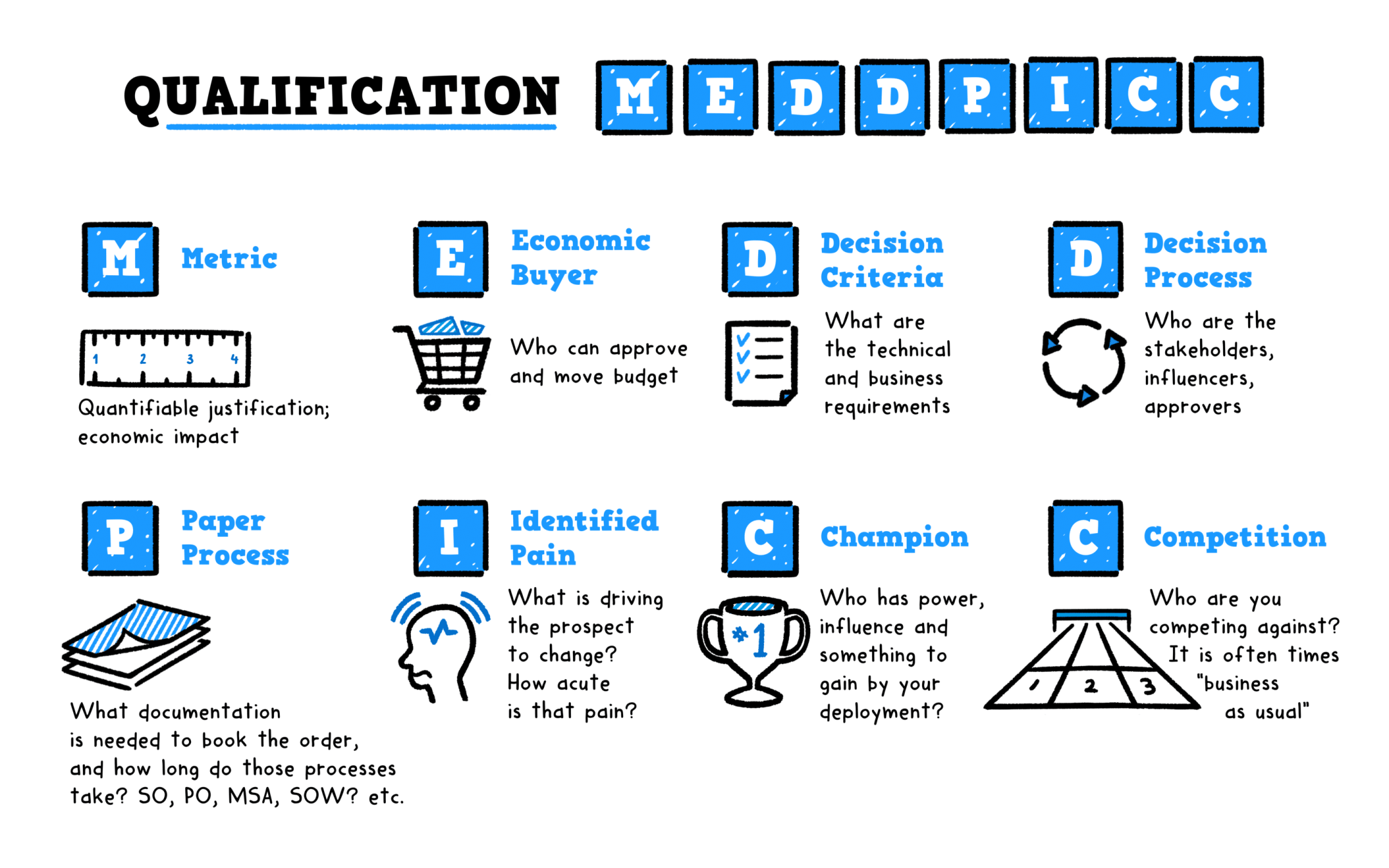Often used in B2B sales, one of the first well-known qualification methods was the incredibly popular BANT, which was developed by IBM way back in the 1950's.
Since then, how many qualification methods and frameworks do you think have been developed? Do you recall any of them?
The amount is difficult to estimate because of countless variations, but there is a handful of ones that are widely used today. If I name you just a few such as the MEDDIC, FAINT, or CHAMP, will they ring any bells?
If yes, I'm not surprised and let's have a recap. If they don't... well you are in for a treat! Why qualify leads, prospects or opportunities, and why are the revenue driving teams so obsessed with these methods? How did BANT survive this long as the world evolved, and how do I think it needs to change for the better? Let's find out!
Before diving in, I wanted to let you know that in the coming weeks I'll be writing a couple of articles about what I call the "holy grail" of documents and tools that I've developed to handle any type of discovery call or a sales demo with confidence. If you are only starting out in sales and want to take a shortcut via my experience, stay tuned for more posts like this and sign up with your email below.
I am happy to have you on board!
What is sales qualification and what is BANT?
Let me get some of the basics out of the way first. A prospect is a potential future customer whom you have identified and who resembles your ideal customer persona, but who hasn't yet expressed any interest in your product or service. A lead on the other hand is a possible future customer who in some way has already expressed interest in what you are offering.
Prospecting is the first stage in a typical outbound sales process where you reach out to possible customers. Next you move on to gather key information in order to determine if the prospect or lead becomes qualified. Such information can be the business need, purchasing authority, or who would stand to benefit the most if your product was to be acquired.
As I mentioned earlier, BANT is one of the most commonly used methods or criteria for gathering such information. It has remained relevant for a long time because it is easy to teach and remember while being suited well to any industry. BANT stands for Budget, Authority, Need and Timing. The letters remind you about what is important to know for assessing the likeliness of the prospect or lead becoming a customer.
Examples:
- Budget: Does the prospect have the money to buy our product or service? How much money do they have available? Which budget does it come from?
- Authority: How are the decision makers involved in the process? Who makes the final decision? Do we have access to this person?
- Need: Is there a need for what we offer? Is there a pain that we can solve? How significant or quantifiable is that pain?
- Timeline: Is there a date by when the prospect needs to have their need fulfilled or the pain addressed? When and how will the decision be made? What is the impact if the pain remains unsolved?
Why qualify?
In order to make the sales process more effective, sales teams enforce a set of qualification criteria to ensure that sales engagements warrant the investment of time and resources. A sales qualification framework protects the sales team's resources by helping to prioritize sales qualified opportunities that are most likely to close.
From the buyer's perspective it helps them better understand their problem and how to solve it while optimizing their use of time. Ideally, it also helps the buyer to get internal buy-in that is necessary to fund the solution.
For the seller, sales qualifying questions optimize the use of time, but also ensure that all of the activities impact revenue. As I mentioned in my previous post about writing effective follow ups, certainty is always better than uncertainty, and the qualification frameworks help eliminate unnecessary surprises while also helping to define the next steps. It also serves as a tool for coaching salespeople while identifying problems within a sales opportunity.
In this post I will still mention the following qualification approaches and tell you how some of them have evolved, or need to evolve in order to stay relevant in the ever-changing buyer landscape:
- FAINT, ANUM and CHAMP
- GPCT
- MEDDIC and MEDDPICC
- How can we modernize and improve the good old BANT?
- Conclusions
FAINT, ANUM and CHAMP
FAINT is commonly used by salespeople who work in an environment where customers don't have set budgets. It is slightly different from BANT in that it puts less emphasis on the client's budget. Otherwise there are lots of similarities.
Funds: Instead of focusing on a set budget, FAINT shifts the perspective onto the overall purchasing power and payment capability of the prospect.
Authority: Same as in BANT.
Interest: Here the salesperson focuses on developing genuine interest in the prospect with the means of educating and connecting the dots from the solution onto how it can help the prospect's business.
Need: Same as in BANT.
Timing: Same as in BANT.
Organizations might use the ANUM framework in order to focus their time on sales qualified leads that can actually make the decision to buy instead of focusing on development of internal champions or other personas who could support the deal.
Authority: Same as in BANT.
Need: Same as in BANT.
Urgency: Can the prospect make a decision quickly or is the salesperson expecting a long process?
Money: Same as funds in FAINT.
CHAMP is simlar to ANUM but puts the customers challenges first. An additional difference here is that the first two letters are part of the same thing as you can see below.
Challenges: What obstacles does the prospect face and can the salesperson's product help solve them?
Authority: Same as in BANT.
Money: Same as in ANUM.
Prioritization: How important is it for the prospect to solve the problem compared to their other priorities?
Whew, now let's actually learn about something more distinct than just slight variations of the same.
GPCT
GPCT was developed by the inbound marketing gurus at HubSpot who aim to turn qualification further in the direction of serving the allmighty self-educated customer. This is a great addition to teams that already use BANT and is best suited for qualifying inbound leads.
Goals: What are the quantifiable goals that the customer wants to achieve? This assumes that at the basic level business seek to do one of three: make more money, save money, or avoid the risk of losing money.
Plans: Did the prospect already try to solve this problem before? How did they do it? Do they have plans in place to try and solve it better this time? This is the salesperson's chance to educate and share his or her own perspectives on whether the plan could work.
Challenges: The intention is to make the prospect feel that they are stuck by identifying and lifting up the challenges front and center. The aim is to recap the pains in order to sway the prospect into action instead of reverting back to doing nothing.
Timeline: Same as in BANT, except includes the compelling event. What triggered the need and why would the prospect buy right now? Is the project a priority?
You can read more about how HubSpot uses this lead qualification criteria together with Budget and Authority in their blog.
MEDDIC(C) and MEDDPICC
The MEDDIC qualification process was developed by PTC and is best suited for sales professionals working in a complex enterprise sales environment. It is also particularly well established in multi-tiered sales organizations where the initial discovery and qualification may be first done by one person (such as an SDR or a BDR) and then handed over to a quota bearing salesperson for closing.
As taken from the MEDDIC Academy website:
Metrics: Measure the potential gain leading to the economic benefit of your solution vs. competition.
Economic buyer: Identify and meet the person who has the ultimate word to release funds to purchase.
Decision process: Know and Influence the process defined by the client to make purchase decision.
Decision criteria: Know and Influence the criteria defined by the client to make purchase decision.
Identify pain: Identify and Analyze the pains which require your solution to be relieved.
Champion: Identify, Qualify, Develop and Test your Champion or your Internal Seller.
(C)ompetition: Sometimes added separately to the standard MEDDIC. Knowing the competitors as well as understanding their strengths and weaknesses can be an important data point for increasing the chances of closing the deal.
A global SaaS company Zendesk boldly claims to be capable of forecasting revenue with 1% accuracy through a well structured sales process and adding a letter "P" to the qualification criteria. The monster that is MEDDPICC is one of my favorite qualification criteria and it adds the formal paper process into the mix. Paper process means the understanding of all the required formalities, procurement, legal documents and contracts that need to be signed in order to successfully close the deal.

You can also use a three point scoring system where each letter and a zero next to it would mean complete lack of information, number one could stand for partial information, and a two could mean the full and confirmed information for the data point. This could serve for you as your detailed qualification checklist or a sales qualification template.
How can we modernize and improve the good old BANT?
There is an incredible article out there from Jacco Van der Koij, which discusses how BANT misses the mark in the modern world. I wanted to let you know about Jacco's points as they completely align with my own thinking in addressing some of the BANT's shortcomings.
Where does the old BANT fall apart?
- As subscription models become more widespread in the B2B sector, lots of solutions no longer require a significant upfront CapEx (Capital Expenditure) investment. Instead the investment may now be considered an ongoing OpEx cost (Operational Expenditure). What does it mean for the letter B?
- Lots of organizations no longer have a single decision maker and are way less hierarchical. What does it mean for the letter A?
- Are you selling something that is truly a must-have, or is your product or service like a lot of things out there just a nice to have? What does it mean for the letter N?
- When so many things can today be implemented with a single click and products are commonly easy to use, is there really a timeline or an implementation period that you or your customer need to know? What does it mean for the letter T?
In general we live in a much more customer-centric environment than 50 years ago and this is why BANT might start to show its age with questions that focus on your needs as the seller.
How should the BANT be updated for the 21st century?
- Instead of qualifying the budget or even the customer's capability to pay, focus on their priorities and situations where your product or service would be of high importance to the prospect.
- Instead of focusing on identifying who is the sole decision maker and having access to this person, work to understand the decision process in general. A good question to ask by a software company would be for example: "How do you typically buy software?" or "Who else decides on this together with you?".
- Instead of assessing and quantifying the needs, dig deeper to understand the impact that your solution could provide helping you move from the nice to have dead-zone into a must have.
- Instead of understanding the initial timeline for making the decision and implementation, understand the critical trigger that is making the prospect act right now. Try to find out what happens if customer misses the initally planned dates. If you as a salesperson understand what triggers the action and why the customer wants to solve it by a certain date you have significant leverage to keep progressing the deal.
Thus, as Jacco mentions, the BANT is still kind of valid, but it just needs to be modernized:
B = Budget = Priority for the customer.
A = Authority = Decision process the customer goes through.
N = Need = Impact on the customer business.
T = Timeline = Critical event for the customer.
Conclusions
Out of all the frameworks and methods listed above, BANT and MEDDICC remain the closest opportunity qualification criteria to my heart. I use them in my work every day and give you a warm recommendation to use them too.
If you liked the article, consider sharing this with your colleagues or subscribing for occasional updates and articles like this one. You will not miss a thing and they'll land right into your inbox!
Sources:
BANT opportunity identification criteria - IBM
Why is Qualification So Important to Your Sales Process? - Force Management
Qualified prospect - Wikipedia
BANT Isn't Enough Anymore - HubSpot
Definition of MEDDIC - 01Consulting
How Zendesk is able to forecast revenue within 1% - Zendesk & Aaron Ross
BANT and Beyond - SalesHacker

